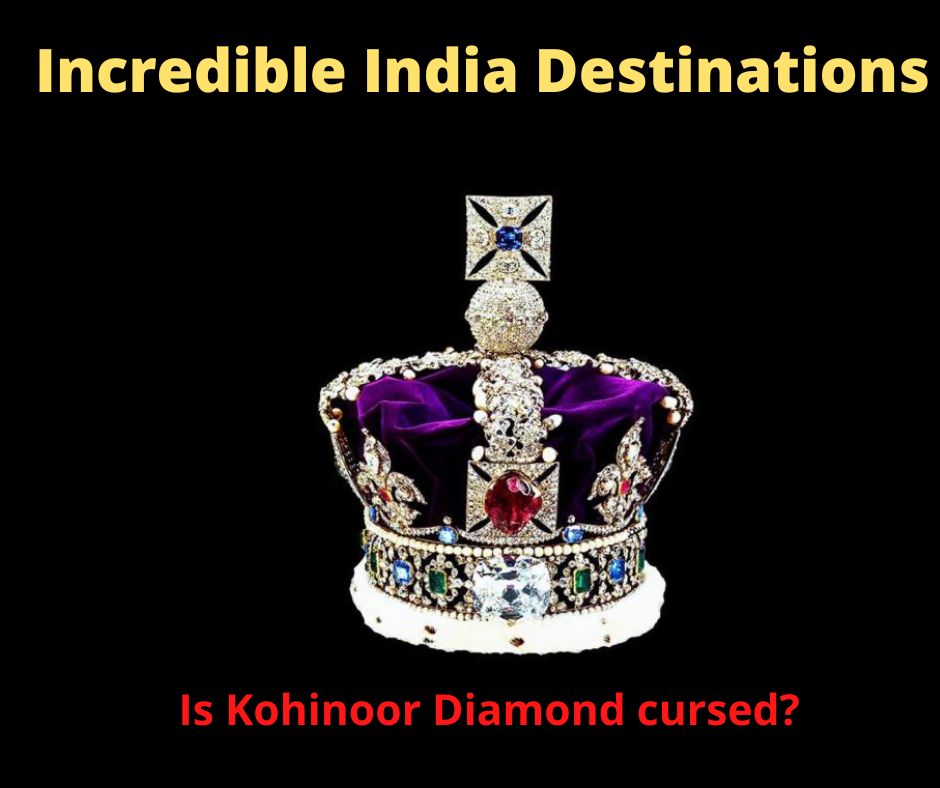Is Kohinoor Diamond cursed?
Description of the Kohinoor Diamond (aka Koh-i-Noor)
The Kohinoor Diamond is one of the most famous diamonds in the world. The Kohinoor diamond was first mentioned in 1306 when it was taken from a Rajah of Malwa, whose family had held the diamond for centuries. It was described as weighing 186 carats and was an oval cut white diamond – the shape and size of a small hen’s egg. The Kohinoor diamond belonged to various Indian and Persian rulers but it became part of the Crown Jewels of England at the time that Queen Victoria was proclaimed empress of India. The Kohinoor was re-cut at this time and now weighs 108.93 carats and is kept in the Tower of London.
Origin / Meaning of the name Kohinoor Diamond (aka Koh-i-Noor)
The Kohinoor (Koh-i-Noor) originated from India in Golconda at the Kollur mine and was specifically mined from the *Rayalaseema diamond mine (meaning *Land of Stones) during the rule of the Kakatiya dynasty. The Kohinoor was then passed from one ruling dynasty to the next. The original name of the diamond was ‘Samantik Mani’ (Prince and leader among diamonds). In 1739 Nadir Shah, the King of Persia, invaded India and was said to refer to the diamond as the “Mountain of Light”. The Persian-Arabic words for “Mountain of Light” were Koh-i-Noor. The magnificence of the diamond and its value symbolized the power of an Empire. It was said that “He who owns this diamond will own the world, but will also know all its misfortunes.” Possession of the Kohinoor led to murder, torture, mutilation and treachery and stories of the Curse of the Kohinoor Diamond…
The Curse of the Kohinoor Diamond (aka Koh-i-Noor)
The Curse of Kohinoor Diamond dates back to a Hindu text from the time of the first authenticated appearance of the diamond in 1306. The Curse of the Kohinoor Diamond reads:
“He who owns this diamond will own the world, but will also know all
it’s misfortunes. Only God, or a woman, can wear it with impunity.”
The history and lives of the rulers who owned the Koh-i-Noor diamond were filled with violence, murders, mutilations, torture and treachery. Whether or not people believe in the Curse of the Kohinoor Diamond, the history of the stone is undeniable – and the threat of the Koh-i-Noor curse is enough to make people cautious. The British Royal families were obviously aware of the Curse of the Kohinoor and from the reign of Queen Victoria, when the Kohinoor diamond came into their possession, it has always gone to the wife of the male heir to the British throne. The History Timeline details the story of the Kohinoor diamond.
The Journey of the Kohinoor Diamond
The following timeline & history of the Kohinoor details important historical events and dates:
| Dates in History of the Kohinoor | Timeline & History of Kohinoor Diamond (aka Koh-i-Noor) |
| 1200 – 1300’s | There were many dynasties who owned the Kohinoor diamond including the Slave dynasty (1206-90), the Khilji dynasty (1290-1320), the Tughlaq dynasty (1320-1413), the Sayyid dynasty (1414-51), and the Lodi dynasty (1451-1526)These were all brief reigns ending with war and violence |
| 1306 | In 1306 the Rajah of Malwa was forced to give the diamond to the rulers of the Kakatiya Empire |
| 1323 | Soon after, in 1323, the Kakatiya Empire fell after a rule stretching from 1083 to 1323. The diamond was taken by Muhammad bin Tughluq who became the Sultan of Delhi from 1325 to 1351 |
| 1323 – 1526 | The diamond came into the possession of the Delhi Sultanate which consisted of many Muslim dynasties that ruled in India to 1526. During the Delhi Sultanate Muslim armies consisting of Mongol, Turkic, Persian, and Afghan warriors invaded India |
| 1526 | In 1526 the Kohinoor Diamond passed to the Mughal Empire when the Timurid Prince Babur defeated Ibrahim Lodi, the last of the Delhi Sultans, at the First Battle of Panipat. Mughal is the Persian word for Mongol |
| Babur mentions in his memoirs, the Baburnama, that the diamond had belonged to an un-named Rajah of Malwa | |
| The Mughal Empire ruled most of the Indian subcontinent for two hundred years and the Kohinoor passed from one Mughal Emperor to the next. Violence and bloodshed followed these years often marked by the sons of the Emperors rebelling and overtaking their fathers | |
| The Mughal Emperor Shah Jahan (1592 – 1666), who was famous for building the Taj Mahal, had the Kohinoor Diamond placed into his ornate Peacock Throne | |
| 1639 | The Koh-i-Noor changed ownership several more times until the Mughal emperor Shah Jahan took the throne. In 1639 a struggle for the Empire started between his four sons – Dara Shikoh, Shah Shuja, Aurangzeb and Murad Baksh when brother killed brother. Shah Shuja executed his brother Dara Shikoh and in then 1658 Aurangzeb defeated Shuja and he was tortured to death together with all his family |
| 1665 | In 1665 Jean-Baptiste Tavernier (1605 – 1689), French traveller and pioneer of jewelry and diamond trade with India, recorded his experiences in which he describes a great Mughal diamond said to be the biggest in the world. It was called the “Great Mogul” by Tavernier |
| 1739 | In 1739 the Persian King Nadir Shah invaded the Mughal Empire defeating their Emperor and stole the great Koh-i-Noor diamond (Nadir Shah is credited with giving the diamond the name it is known by today). The Koh-i-Noor Diamond was taken to Persia |
| 1747 | In 1747 the empire of Nadir Shah quickly disintegrated after he was assassinated – the Curse of the Kohinoor strikes again? After Nadir Shah’s assassination, the diamond passed to his successors, each were dethroned and ritually blinded (Blinding was used to render an enemy powerless and make him a burden on his community.) |
| 1800 | Ranjit Singh took the Empire and possession of the Kohinoor diamond. Rajah Ranjit Singh died in 1839 and his successors lacked his bravery and vision |
| The Sikh kingdom became weak and the British conquered India which became part of the British Empire and the British Raj or rule gained control of India from 1858 – 1947 | |
| The British Governor-General of India, Lord Dalhousie, was responsible for the British acquiring the Koh-i-Noor | |
| 1851 | Dalhousie arranged that the Kohinoor diamond should be presented by Ranjit Singh’s successor, Duleep Singh, to Queen Victoria, the Empress of India |
| 1851 | The Great Exhibition was staged in Hyde Park in London when the Koh-i-Noor was put on view to the British public |
| 1852 | In 1852 Prince Albert ordered that the Koh-i-Noor diamond to be re-cut from 186 carats to its current 105 carats thus increasing its brilliance. The Koh-i-Noor diamond was mounted in a tiara with more than two thousand other diamonds |
| The Koh-i-Noor diamond was then used as the centre piece of the crowns of the Queen consorts to the British Kings. The Queen Consorts Queen Alexandra and Queen Mary wore the crowns | |
| 1936 | In 1936, the stone was set into the crown of the wife of King George VI, Queen Elizabeth (later known as the Queen Mother), wife of King George VI |
| The British Royal families were obviously aware of the Curse of the Kohinoor – “He who owns this diamond will own the world, but will also know all its misfortunes. Only God, or a woman, can wear it with impunity.” And from the reign of Queen Victoria the Kohinoor diamond has always gone to the wife of the male heir to the British throne |
Why History calls it as Curse of the Kohinoor Diamond?
Myths and legends surround the stone. It was of incredible value and described by one of its owners, the Emperor Babur, the Great Mughal, as “Worth the value of one day’s food for all the people in the world”. The men who fought for it, and the Kingdoms and great Empires that were won and lost, produced many stories of ill-luck that plagued the owners and became part of the history of the Kohinoor diamond.
By the 16th century, the stone had fallen into the hands of the first Mughal emperor, Babur, whose son was the first to fall foul of the “curse” by being driven from his kingdom into exile.
The later Mughal ruler, Shah Jahan, who built the Taj Mahal, had the diamond placed into the famous Peacock Throne of the dynasty but spent his last days watching its reflection through a barred window after being imprisoned by his son, Aurangzeb.
It was only after the Mughals had been deposed and control of the diamond passed to the Persians that the Koh-i-Noor received its present day name.
The story has it that Nadir Shah, the conqueror of the Mughals, was preparing to return home after sacking Delhi in 1736 when he realized the diamond was missing from his booty.
He was supposedly tipped off by a disenchanted member of the Mughal emperor’s harem that his enemy kept it hidden in his turban. Using an old war custom, Nadir Shah proposed an exchange of turbans. As the gem fell to the ground from the unfurling cloth and caught the light, Nadir Shah is said to have proclaimed: “koh i noor.”
Since then, the diamond has been lured after by its owners, who have been hypnotized by its value and status. As one of Nadir Shah’s courtiers put it: “If a strong man should take five stones and throw one north, one south, one east and one west, and the last straight up in the air, and then the space between filled with gold and gems, that would equal the value of the Koh-i-Noor.”
After the assassination of Nadir Shah, another victim of the curse, the diamond passed through the hands of his successors, each dethroned and ritually blinded, until it was passed in return for sanctuary to Ranjit Singh, the Lion of Lahore, self-declared ruler of Punjab and father of Duleep Singh.
Within 40 years, the stone had passed into the possession of Lord Dalhousie after a military campaign every bit as ruthless and blood-soaked as those which had previously been fought for possession of the Koh-i-Noor. What followed was a process of the Anglicization of the diamond.
After Prince Albert had it trimmed it was mounted in a tiara, while Prince Duleep was made a ward of the British Crown complete with an annual stipend of £50,000. He converted to Christianity and became a member of the racy circle of the young Edward VII, but died in poverty in Paris in 1893.
Some historians have pointed out that, after the possession of the diamond by British monarchy, the British Empire started shrinking and now reduced to United Kingdom.
Read More……..
Did Shah Jahan amputated the hands of the workers of the Taj Mahal




